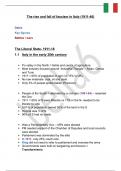Summary
The Rise and Fall of Fascism in Italy (c.) course summary notes
- Institution
- PEARSON (PEARSON)
These notes act as a summarised form of the entire sub-unit course and also includes highlights for the key categories of 1. Dates, 2. Key figures and 3. Battles to help with identifying useful facts and figures.
[Show more]



